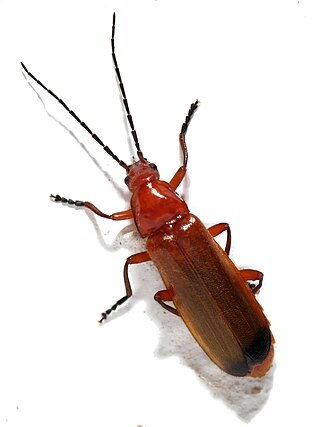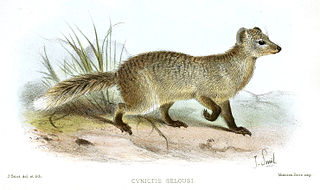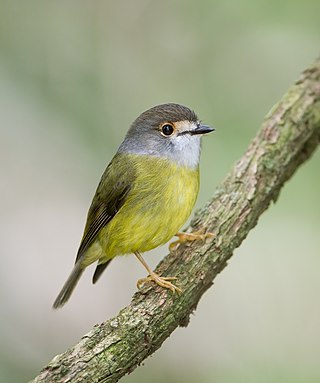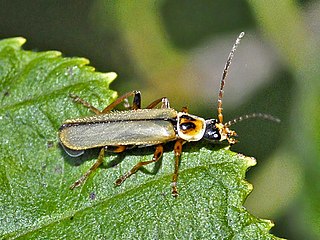
The desert wheatear is a wheatear, a small passerine bird that was formerly classed as a member of the thrush family Turdidae, but is now more generally considered to be an Old World flycatcher (Muscicapidae). It is a migratory insectivorous species, 14.5 to 15 cm in length. Both western and eastern forms of the desert wheatear are rare vagrants to western Europe. The western desert wheatear breeds in the Sahara and the northern Arabian peninsula. The eastern race is found in the semi-deserts of Central Asia and in winter in Pakistan and northeast Africa.

The waxwings are three species of passerine birds classified in the genus Bombycilla. They are pinkish-brown and pale grey with distinctive smooth plumage in which many body feathers are not individually visible, a black and white eyestripe, a crest, a square-cut tail and pointed wings. Some of the wing feathers have red tips, the resemblance of which to sealing wax gives these birds their common name. According to most authorities, this is the only genus placed in the family Bombycillidae, although sometimes the family is extended to include related taxa that are more usually included in separate families: silky flycatchers, Hypocolius (Hypocoliidae), Hylocitrea (Hylocitreidae), palmchats (Dulidae) and the Hawai'ian 'honeyeaters' (Mohoidae). There are three species: the Bohemian waxwing, the Japanese waxwing and the cedar waxwing.

The lesser grey shrike is a member of the shrike family Laniidae. It breeds in South and Central Europe and western Asia in the summer and migrates to winter quarters in southern Africa in the early autumn, returning in spring. It is a scarce vagrant to western Europe, including Great Britain, usually as a spring or autumn erratic.

The northern shoveler, known simply in Britain as the shoveler, is a common and widespread duck. It breeds in northern areas of Europe and across the Palearctic and across most of North America, wintering in southern Europe, the Indian subcontinent, Southeast Asia, Central, the Caribbean, and northern South America. It is a rare vagrant to Australia. In North America, it breeds along the southern edge of Hudson Bay and west of this body of water, and as far south as the Great Lakes west to Colorado, Nevada, and Oregon.

The rosy starling is a passerine bird in the starling family, Sturnidae, also known as the rose-coloured starling or rose-coloured pastor. The species was recently placed in its own monotypic genus, Pastor, and split from Sturnus. This split is supported by recent studies, though other related species within its new genus are not yet known for certain.

The Caspian tern is a species of tern, with a subcosmopolitan but scattered distribution. Despite its extensive range, it is monotypic of its genus, and has no accepted subspecies. The genus name is from Ancient Greek hudros, "water", and Latin progne, "swallow". The specific caspia is from Latin and, like the English name, refers to the Caspian Sea.

The glaucous gull is a large gull, the second-largest gull in the world. It breeds in Arctic regions of the Northern Hemisphere and winters south to shores of the Holarctic. The genus name is from Latin larus, which appears to have referred to a gull or other large seabird. The specific name hyperboreus is Latin for "northern" from the Ancient Greek Huperboreoi people from the far north "Glaucous" is from Latin glaucus and denotes the grey colour of the gull. An older English name for this species is burgomaster.

Hypericum is a genus of flowering plants in the family Hypericaceae. The genus has a nearly worldwide distribution, missing only from tropical lowlands, deserts and polar regions. Many Hypericum species are regarded as invasive species and noxious weeds. All members of the genus may be referred to as St. John's wort, and some are known as goatweed. The white or pink flowered marsh St. John's worts of North America and eastern Asia are generally accepted as belonging to the separate genus TriadenumRaf.

The black-crowned tchagra is a bushshrike. This family of passerine birds is closely related to the true shrikes in the family Laniidae, and was once included in that group.

Primula vulgaris, the common primrose, is a species of flowering plant in the family Primulaceae, native to western and southern Europe, northwest Africa, and parts of southwest Asia. The common name is primrose, or occasionally common primrose or English primrose to distinguish it from other Primula species also called primroses. None of these are closely related to the evening primroses.

Cicindela, commonly known as common tiger beetles are generally brightly colored and metallic beetles, often with some sort of patterning of ivory or cream-colored markings. They are most abundant and diverse in habitats very often near bodies of water with sandy or occasionally clay soils; they can be found along rivers, sea and lake shores, sand dunes, around dry lakebeds, on clay banks, or woodland paths.

Rhagonycha fulva, the common red soldier beetle, also misleadingly known as the bloodsucker beetle, and popularly known in England as the hogweed bonking beetle is a species of soldier beetle (Cantharidae).

Selous's mongoose is a mongoose species native to Southern Africa. It is the only member of the genus Paracynictis.

The red-winged starling is a bird of the starling family Sturnidae native to eastern Africa from Ethiopia to the Cape in South Africa. An omnivorous, generalist species, it prefers cliffs and mountainous areas for nesting, and has moved into cities and towns due to similarity to its original habitat.

The blue vanga is a bird species in the family Vangidae. It is in the monotypic genus Cyanolanius. It is found in Comoros, Madagascar, and Mayotte, where its natural habitats are subtropical or tropical dry forest and subtropical or tropical moist lowland forest.

The bearded scrub robin, also known as the eastern bearded scrub robin, is a species of bird in the family Muscicapidae. It is found in eastern and southern Africa.

The pale-yellow robin is a species of passerine bird in the family Petroicidae. It is endemic to eastern Australia. Its natural habitat is subtropical or tropical moist lowland forests. It is a nondescript bird with grey head and olive upperparts, white throat and yellow underparts. The sexes are similar. Two subspecies are recognised: the smaller nana from North Queensland, and the larger and uncommon nominate race capito from southeast Queensland and northeastern New South Wales. It is insectivorous.

The black-headed sugar ant, also known as the brown sugar ant, is a species of Formicinae ant endemic to Australia. Found throughout most states, the species is a member of the genus Camponotus, a cosmopolitan genus of ants commonly known as carpenter ants. It was formally described and named by British entomologist Frederick Smith in 1858. These ants are characterised by their black head, reddish-brown mesosoma and black gaster, which can change in colour.

Metacantharis is a genus of soldier beetle belonging to the family Cantharidae.

The meridional serotine is a species of bat native to the Iberian Peninsula, Morocco, Algeria, Tunisia and Libya.




















